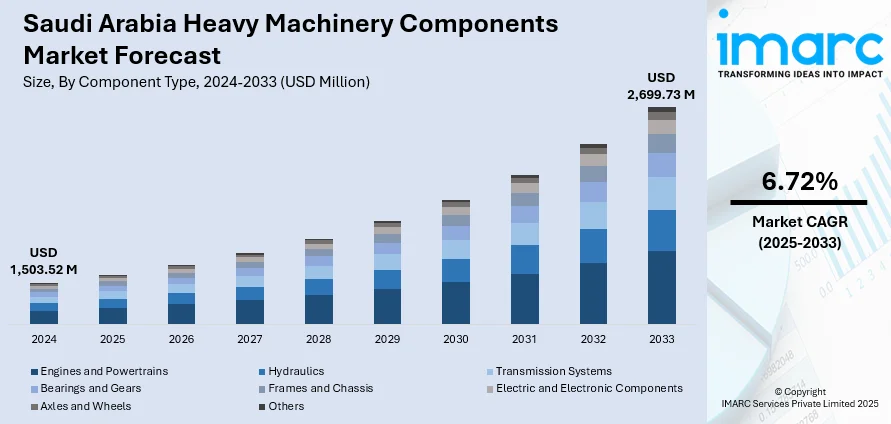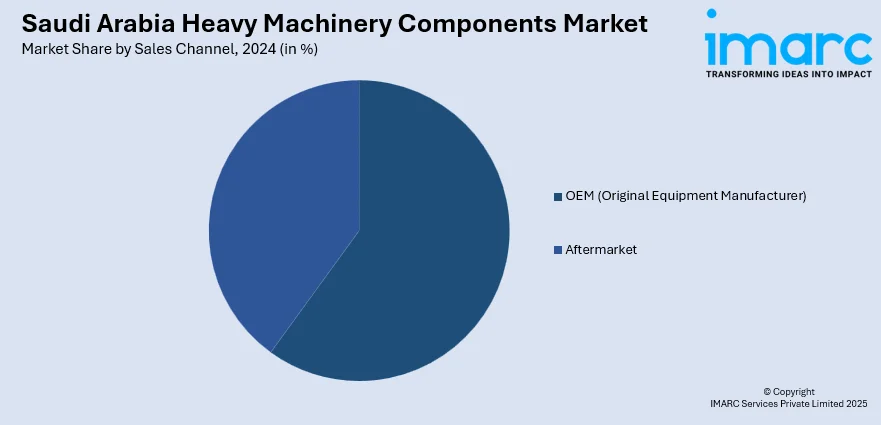
Saudi Arabia Heavy Machinery Components Market Size, Share, Trends and Forecast by Component Type, Material Type, Machinery Type, Sales Channel, End Use Industry, and Region, 2025-2033
Saudi Arabia Heavy Machinery Components Market Overview:
The Saudi Arabia heavy machinery components market size reached USD 1,503.52 Million in 2024. Looking forward, IMARC Group expects the market to reach USD 2,699.73 Million by 2033, exhibiting a growth rate (CAGR) of 6.72% during 2025-2033. The market is propelled by mega-sized infrastructure projects of Vision 2030, which is set to diversify the economy and decreased dependence on oil. Heavy investments in construction, mining, and industry sectors are boosting demand for rugged and high-performance machine components. NEOM and Red Sea Project, drive for domestic production through the "Made in Saudi" initiative, along with technological improvements in automation and efficiency, is further driving market expansion and increasing the Saudi Arabia heavy machinery components market share.
|
Report Attribute
|
Key Statistics
|
|---|---|
|
Base Year
|
2024 |
|
Forecast Years
|
2025-2033
|
|
Historical Years
|
2019-2024
|
| Market Size in 2024 | USD 1,503.52 Million |
| Market Forecast in 2033 | USD 2,699.73 Million |
| Market Growth Rate 2025-2033 | 6.72% |
Saudi Arabia Heavy Machinery Components Market Trends:
Integration of Smart Technologies and Automation
Saudi Arabia's components market for heavy machinery is significantly influenced by the integration of automation and smart technologies. Companies are adding Artificial Intelligence (AI), Machine Learning (ML), and Internet of Things (IoT) devices to make operations more efficient and predictive maintenance. These innovations allow for real-time monitoring of equipment performance, minimizing downtime and maintenance costs. Moreover, autonomous machinery adoption is increasing, especially in remote and dangerous environments, enhancing safety and productivity. This is in line with the Kingdom's overall Vision 2030 objectives of promoting innovation and technological development in different sectors. Consequently, the market for sophisticated machinery components that enable these technologies is projected to increase, propelling the Saudi Arabia heavy machinery components market growth.

Transition Toward Sustainable and Energy-Efficient Equipment
Environmental sustainability is increasingly becoming a major concern in Saudi Arabia's heavy machinery components industry. By 2060, the Kingdom of Saudi Arabia (KSA) aims to achieve net zero greenhouse gas (GHG) emissions, targeting 50% renewable energy and cutting down 278 million tons of CO2 equivalent annually by 2030 as part of Vision 2030. This bold plan emphasizes economic variety, international involvement, and improved living standards. The electricity industry, boasting a 90 GW installed capacity in 2020, is crucial for decarbonization, targeting a 55% decrease in emissions by 2030. Hence, electric and hybrid construction equipment are increasingly becoming popular because they have a lower carbon footprint and are cheaper to operate. This is prompting manufacturers to develop equipment that meets green building requirements and certification. This transition benefits the Kingdom's environmental goals, it also responds to the increasing international focus on green building practices worldwide. Therefore, demand for components allowing the creation of such green machinery is rising.
Localization of Manufacturing and Supply Chains
Consistent with Vision 2030, Saudi Arabia is pushing the localization of manufacturing and supply chains in the heavy machinery components market. The "Made in Saudi" program promotes local production, which seeks to minimize dependence on imports and trigger local industries. The strategy entails the development of local manufacturing plants and joint ventures with foreign companies to improve technological abilities and provide employment opportunities. Through the development of local industries, the Kingdom hopes to enhance its economic resilience and provide a constant supply of machinery parts to serve the increasing demand generated by infrastructure and industrial schemes. This shift is reconfiguring the market environment, enhancing self-sufficiency, and serving the larger objectives of economic diversification.
Saudi Arabia Heavy Machinery Components Market Segmentation:
IMARC Group provides an analysis of the key trends in each segment of the market, along with forecasts at the country and regional levels for 2025-2033. Our report has categorized the market based on component type, material type, machinery type, sales channel, and end use industry.
Component Type Insights:
- Engines and Powertrains
- Hydraulics
- Pumps
- Valves
- Cylinders
- Transmission Systems
- Bearings and Gears
- Frames and Chassis
- Electric and Electronic Components
- Axles and Wheels
- Others
The report has provided a detailed breakup and analysis of the market based on the component type. This includes engines and powertrains, hydraulics (pumps, valves, and cylinders), transmission systems, bearings and gears, frames and chassis, electric and electronic components, axles and wheels, and others.
Material Type Insights:
- Steel
- Aluminum
- Cast Iron
- Composites
- Others
A detailed breakup and analysis of the market based on the material type has also been provided in the report. This includes steel, aluminum, cast iron, composites, and others.
Machinery Type Insights:
- Construction Equipment
- Mining Equipment
- Agriculture Equipment
- Industrial Machinery
- Oil and Gas Equipment
- Others
A detailed breakup and analysis of the market based on the machinery type has also been provided in the report. This includes construction equipment, mining equipment, agriculture equipment, industrial machinery, oil and gas equipment, and others.
Sales Channel Insights:

- OEM (Original Equipment Manufacturer)
- Aftermarket
A detailed breakup and analysis of the market based on the sales channel has also been provided in the report. This includes OEM (original equipment manufacturer) and aftermarket.
End Use Industry Insights:
- Construction and Infrastructure
- Mining and Metallurgy
- Agriculture
- Manufacturing
- Oil and Gas
- Energy and Power
- Others
The report has provided a detailed breakup and analysis of the market based on the end use industry. This includes construction and infrastructure, mining and metallurgy, agriculture, manufacturing, oil and gas, energy and power, and others.
Regional Insights:
- Northern and Central Region
- Western Region
- Eastern Region
- Southern Region
The report has also provided a comprehensive analysis of all the major regional markets, which include Northern and Central Region, Western Region, Eastern Region, and Southern Region.
Competitive Landscape:
The market research report has also provided a comprehensive analysis of the competitive landscape. Competitive analysis such as market structure, key player positioning, top winning strategies, competitive dashboard, and company evaluation quadrant has been covered in the report. Also, detailed profiles of all major companies have been provided.
Saudi Arabia Heavy Machinery Components Market Report Coverage:
| Report Features | Details |
|---|---|
| Base Year of the Analysis | 2024 |
| Historical Period | 2019-2024 |
| Forecast Period | 2025-2033 |
| Units | Million USD |
| Scope of the Report |
Exploration of Historical Trends and Market Outlook, Industry Catalysts and Challenges, Segment-Wise Historical and Future Market Assessment:
|
| Component Types Covered |
|
| Material Types Covered | Steel, Aluminum, Cast Iron, Composites, Others |
| Machinery Types Covered | Construction Equipment, Mining Equipment, Agriculture Equipment, Industrial Machinery, Oil and Gas Equipment, Others |
| Sales Channels Covered | OEM (Original Equipment Manufacturer), Aftermarket |
| End Use Industries Covered | Construction and Infrastructure, Mining and Metallurgy, Agriculture, Manufacturing, Oil and Gas, Energy and Power, Others |
| Regions Covered | Northern and Central Region, Western Region, Eastern Region, Southern Region |
| Customization Scope | 10% Free Customization |
| Post-Sale Analyst Support | 10-12 Weeks |
| Delivery Format | PDF and Excel through Email (We can also provide the editable version of the report in PPT/Word format on special request) |
Key Questions Answered in This Report:
- How has the Saudi Arabia heavy machinery components market performed so far and how will it perform in the coming years?
- What is the breakup of the Saudi Arabia heavy machinery components market on the basis of component type?
- What is the breakup of the Saudi Arabia heavy machinery components market on the basis of material type?
- What is the breakup of the Saudi Arabia heavy machinery components market on the basis of machinery type?
- What is the breakup of the Saudi Arabia heavy machinery components market on the basis of sales channel?
- What is the breakup of the Saudi Arabia heavy machinery components market on the basis of end use industry?
- What is the breakup of the Saudi Arabia heavy machinery components market on the basis of region?
- What are the various stages in the value chain of the Saudi Arabia heavy machinery components market?
- What are the key driving factors and challenges in the Saudi Arabia heavy machinery components market?
- What is the structure of the Saudi Arabia heavy machinery components market and who are the key players?
- What is the degree of competition in the Saudi Arabia heavy machinery components market?
Key Benefits for Stakeholders:
- IMARC’s industry report offers a comprehensive quantitative analysis of various market segments, historical and current market trends, market forecasts, and dynamics of the Saudi Arabia heavy machinery components market from 2019-2033.
- The research report provides the latest information on the market drivers, challenges, and opportunities in the Saudi Arabia heavy machinery components market.
- Porter's five forces analysis assist stakeholders in assessing the impact of new entrants, competitive rivalry, supplier power, buyer power, and the threat of substitution. It helps stakeholders to analyze the level of competition within the Saudi Arabia heavy machinery components industry and its attractiveness.
- Competitive landscape allows stakeholders to understand their competitive environment and provides an insight into the current positions of key players in the market.
Need more help?
- Speak to our experienced analysts for insights on the current market scenarios.
- Include additional segments and countries to customize the report as per your requirement.
- Gain an unparalleled competitive advantage in your domain by understanding how to utilize the report and positively impacting your operations and revenue.
- For further assistance, please connect with our analysts.
 Request Customization
Request Customization
 Speak to an Analyst
Speak to an Analyst
 Request Brochure
Request Brochure
 Inquire Before Buying
Inquire Before Buying




.webp)




.webp)












